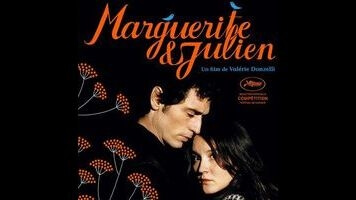Adapted by Donzelli (Declaration Of War) and actor Jérémie Elkaïm from a decades-old screenplay originally intended for French New Wave icon François Truffaut (he opted to do Day For Night instead), Marguerite & Julien puts its influences front and center. It’s based on a real historical case and nominally set in 17th-century France, which is imagined as an anachronistic mishmash of 19th and 20th-century fashion (most of which looks like it was bought off-the-rack at 21st-century clothing stores) and decor. It’s back-to-back waistcoats, out-of-nowhere camera moves, slow-mo shots, vintage pop songs (The Shangri-Las, The Artwoods, etc.), swelling synths, New Wave actor cameos, and book-cover typefaces—cinema as Pinterest board.
Elkaim and Anaïs Demoustier play the brother and sister of the title, who escape into the woods to live as a couple, hoping to eventually escape to England. Both are photogenic in very different ways (he’s got one of those cliff-rock faces that’s all nose and brow; she’s a freckled porcelain teacup), which is good, since they otherwise only register as specks of character. Shot in a haphazard combination of celluloid and digital, Marguerite & Julien’s flat, just-off-center widescreen compositions continually bring to mind a production running out of time and energy at the end of a long day. Lights are diffused into a thick Vaseline smear; combined with interiors barely decorated with the odd draped cloth or potted plant, it makes some scenes look weirdly like old Penthouse photo shoots.
Marguerite & Julien’s romance is a non-item, but Donzelli sprinkles it with faux naiveté, which has the aftertaste of an artificial sweetener. Who would ever want to see this movie? And who could ever look away? It’s rare to find a film that is so generous about being inane. Want a climactic scene that’s shown only as a series of still photos? Out-of-nowhere needle drops of The Stranglers’ “Midnight Summer Dream” or a piece of the score to The Assassination Of Jesse James By The Coward Robert Ford? Geraldine Chaplin scowling in Pierrot makeup and a widow’s veil? Brechtian asides that do diddly-squat? Marguerite & Julien is cloying and tone-deaf, but also unchecked and impulsive in a way that smarter movies generally aren’t.


 Keep scrolling for more great stories from A.V. Club.
Keep scrolling for more great stories from A.V. Club.